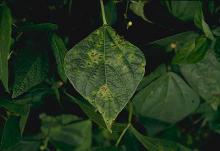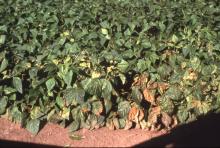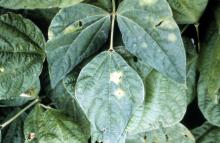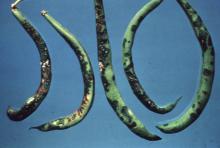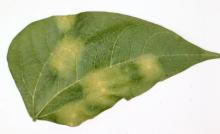Cause Pseudomonas syringae pv. phaseolicola, a bacterium that overwinters primarily in seed but can survive in infected, undecomposed plant debris from the previous year's crop. Rain, irrigation water, tools, equipment, and humans can spread the bacterium. The frequent wet weather in Oregon's Willamette Valley in June favors the development and spread of halo blight. Even under arid conditions of the intermountain west, the disease may spread in rill-irrigated and sprinkler-irrigated fields. Most bush beans, including lima bean, are susceptible to the disease, but 'OSU 91G' has moderate resistance. 'Blue Lake' pole beans are not resistant but seldom become diseased when field grown.
Symptoms The first symptom is water-soaked spots followed by irregular brown spots, usually with yellow halos around them. A bacterial sheen often covers the surface of the spot. Defoliation occurs in severe infections. Leaves on systemically infected plants may show yellowing and malformation without the appearance of necrotic symptoms and infected plants often are stunted.
On the pods, dark, greasy-looking, water-soaked spots appear, often with a bacterial ooze on the surface. The suture often appears dark and water-soaked, too. Spots extend through the pod. Later, spots become dry and brown.
On stems, reddish waxy cankers develop, often girdling and killing plants.
Visually inspecting seed to detect contamination is unreliable because seeds may appear healthy but be heavily contaminated. Severely diseased seeds may be shriveled or discolored.
Cultural control
- Plant pathogen-free seed. This is very important because all outbreaks of the disease in the Pacific Northwest have resulted from planting infected seed. Idaho regulations prohibit planting infected seed and require diseased fields to be plowed under to prevent spread to surrounding fields.
- If you cannot obtain pathogen-free seed, delay planting until dry weather prevails, if possible.
- Avoid frequent irrigations with sprinklers.
- Do not work in diseased fields that are wet with rain or irrigation water.
- Use a 2- to 3-year crop rotation.
- Plow under plant debris as soon as possible after harvest to allow plenty of time for debris to decompose during winter.
Chemical control Bactericides at 7- to 10-day intervals may slow disease spread if it is at low levels in the field.
- AS-50 Agricultural Streptomycin at 0.18 to 0.91 oz/100 lb of seed plus a dye. 12-hr reentry.
- Copper formulations (Group M1) offer limited control.
- Badge SC at 0.5 to 2 pints/A on 7- to 14-day intervals. Preharvest interval is 0 days. 48-hr reentry.
- Bonide Liquid Copper is available for home gardens. H
- Champ Formula 2 at 0.66 to 2 pints/A. 48-hr reentry.
- Champ WG at 1.58 lb/A on 7- to 14-day intervals. 48-hr reentry. O
- Cueva at 0.5 to 2 gal/100 gal water on 7- to 10-day intervals. May be applied on the day of harvest. 4-hr reentry. O
- Cuprofix Ultra 40 Disperss at 0.75 to 2 lb/A on 7- to 14-day intervals. 48-hr reentry.
- Kocide 2000 at 0.75 to 2.25 lb/A or Kocide 3000 at 0.5 to 1.25 lb/A. 48-hr reentry. O
- Nu-Cop 50 DF at 1 to 1.5 lb/A on 7- to 14-day intervals. 48-hr reentry. O
- Previsto at 1 to 2 quarts/A on 7- to 14-day intervals. 48-hr reentry. O


